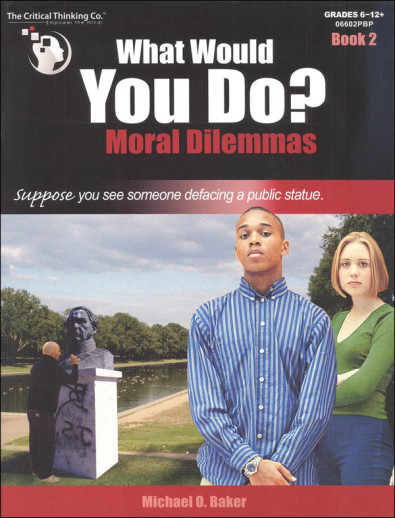We use cookies to make your experience better. To comply with the new e-Privacy directive, we need to ask for your consent to set the cookies. Learn more.
What Would You Do? Moral Dilemmas Book 2
This award-winning collection of ethical dilemmas is used by parents and teachers to initiate important values and ethics discussions. The open-ended questions pose real life problems that require students, Grades 6-12+, to decide what they would do when two or more ethical beliefs are pitted against each other (see sample). The discussions also enable parents and teachers to listen and observe a student's thinking, values, and ethical beliefs. Students often benefit from hearing the thinking and beliefs of others. These dilemmas provoke engaging classroom/family discussions that develop critical thinking skills and explore character-building issues.
Each activity presents students with an initial question for consideration (a moral dilemma) and then asks subsequent questions that add additional insights into the particular situation, forcing the students to reconsider if the new insights should/would change what they would do.
I was a little leery when I first saw these character building books from Critical Thinking Press. Though they're great with workbooks on logic and brain-building, I was doubtful the publisher could pull off good "moral" books. However, I was wrong - the logical way the books present moral problems is great for helping students consider what they would do in different situations. Basically, the book presents a real-life scenario and then asks what you would do in that situation. The first part is usually multiple-choice, but then the book presents additional questions that change the situation or add some complexity, so the students must consider how this changes what they're going to do about the situation. Often the book asks students to explain why they would react the way they would and group discussions prompt students to really get to the heart of the situation and their reaction. The moral dilemmas in the books are geared towards circumstances that children really do face in real life. Book 1 has situations geared for grades 2-5 while Book 2 is geared towards grades 6-12. So, what would you do if a friend told a lie in front of you? What if you're shopping and the cashier rings up a total that's half of what you were expecting? What if the cashier had overcharged you on a previous visit - would that effect whether or not you spoke up? Like all Critical Thinking Press books, these certainly get you thinking - this time about your moral strengths and weaknesses. There are 32 situations (with multiple sub-situations for each) per book. 32 pgs, pb. ~ Rachel S.
| Product Format: | Saddle Stitched Book |
|---|---|
| Brand: | Critical Thinking Company |
| Author: | Michael O. Baker |
| Grades: | 6-12 |
| ISBN: | 9780894553493 |
| Length in Inches: | 11 |
| Width in Inches: | 8.5 |
| Height in Inches: | 0.0625 |
| Weight in Pounds: | 0.25 |

